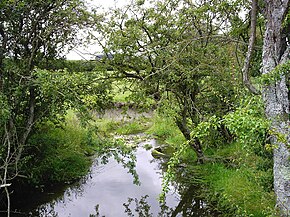River source

Theheadwaterof ariverorstreamis the farthest point on each of itstributariesupstream from itsmouth/estuaryinto alake/seaor itsconfluencewith another river. Each headwater is considered one of the river'ssources,as it is the place wheresurface runoffsfromrainwater,meltwaterand/orspring waterbegin accumulating into a more substantial and consistent flow that becomes afirst-order tributaryof that river. The tributary with the longestcoursedownstream of the headwaters is regarded as themain stem.
Definition
[edit]
TheUnited States Geological Survey(USGS) states that a river's "length may be considered to be the distance from the mouth to the most distant headwater source (irrespective of stream name), or from the mouth to the headwaters of the stream commonly known as the source stream". As an example of the second definition above, the USGS at times considers theMissouri Riveras a tributary of theMississippi River.But it also follows the first definition above (along with virtually all other geographic authorities and publications) in using the combined Missouri—lower Mississippi length figure in lists of lengths of rivers around the world.[1]Most rivers have numerous tributaries and change names often; it is customary to regard the longest tributary or stem as the source, regardless of what name that watercourse may carry on local maps and in local usage.[citation needed]
This most commonly identified definition of a river source specifically uses the most distant point (along watercourses from theriver mouth) in thedrainage basinfrom which water runs year-around (perennially), or, alternatively, as the furthest point from which water could possibly flowephemerally.[2]The latter definition includes sometimes-dry channels and removes any possible definitions that would have the river source "move around" from month to month depending on precipitation or ground water levels. This definition, from geographer Andrew Johnston of theSmithsonian Institution,is also used by theNational Geographic Societywhen pinpointing the source of rivers such as theAmazonorNile.A definition given by the state ofMontanaagrees, stating that a river source is never aconfluencebut is "in a location that is the farthest, along water miles, from where that river ends."[3]
Under this definition, neither a lake (excepting lakes with no inflows) nor a confluence of tributaries can be a true river source, though both often provide the starting point for the portion of a river carrying a single name. For example, National Geographic and virtually every other geographic authority and atlas define the source of the Nile River not asLake Victoria's outlet where the name "Nile" first appears, which would reduce the Nile's length by over 900 km (560 mi) (dropping it to fourth or fifth on the list of world's rivers), but instead use the source of the largest river flowingintothe lake, theKagera River.Likewise, the source of the Amazon River has been determined this way, even though the river changes names numerous times along its course.[4]However, the source of theThamesin England is traditionally reckoned according to the named river Thames rather than its longer tributary, theChurn— although not without contention.[5]
When not listing river lengths, however, alternative definitions may be used. The Missouri River's source is named by some USGS and other federal and state agency sources, followingLewisandClark's naming convention, as the confluence of theMadisonandJefferson Rivers,rather than the source of its longest tributary (the Jefferson).[3]This contradicts the most common definition,[6]which is, according to aUS Army Corps of Engineersofficial on a USGS site, that "[geographers] generally follow the longest tributary to identify the source of rivers and streams." In the case of the Missouri River, this would have the source be well upstream from Lewis and Clark's confluence, "following the Jefferson River to theBeaverhead RivertoRed Rock River,then Red Rock Creek toHell Roaring Creek."[citation needed]
Characteristics
[edit]
Sometimes the source of the most remote tributary may be in an area that is moremarsh-like, in which the "uppermost" or most remote section of the marsh would be the true source. For example, the source of theRiver Teesismarshland.
The furthest stream is also often called the head stream. Headwaters are often small streams with cool waters because of shade and recently melted ice or snow. They may also be glacial headwaters, waters formed by the melting ofglacialice.
Headwater areas are the upstream areas of awatershed,as opposed to the outflow or discharge of a watershed. The river source is often but not always on or quite near the edge of the watershed, or watershed divide. For example, the source of theColorado Riveris at theContinental Divideseparating theAtlantic OceanandPacific Oceanwatersheds ofNorth America.
Example
[edit]Ariveris considered alineargeographic feature, with only one mouth and one source. For an example, theMississippi RiverandMissouri Riversources are officially defined as follows:
- "Largest Rivers in the United States".United States Geological Survey.
- U.S. Geological Survey Geographic Names Information System: Mississippi River,Length: 2,340 miles (3,770 km), Source:47°14′22″N95°12′29″W/ 47.23944°N 95.20806°W
- U.S. Geological Survey Geographic Names Information System: Missouri River,Length: 2,540 miles (4,090 km), Source:45°55′39″N111°30′29″W/ 45.92750°N 111.50806°W
Related usages
[edit]The verb "rise" can be used to express the general region of a river's source, and is often qualified with an adverbial expression of place. For example:
- The River Thames rises in Gloucestershire.
- The White Nile rises in the Great Lakes region of central Africa.
The word "source", when applied tolakesrather than rivers or streams, refers to the lake'sinflow.[7][8]
See also
[edit]References
[edit]- ^"Largest Rivers in the United States"(PDF).United States Geological Survey.Retrieved24 October2009.
- ^"National Geographic News @ nationalgeographic.com".news.nationalgeographic.com.Archived fromthe originalon April 13, 2001.
- ^ab"The True Utmost Reaches of the Missouri".
- ^"IBGE - Instituto Brasileiro de Geografia e Estatística".Archived fromthe originalon 2011-06-15.
- ^Bailey, David (15 May 2012)."Could the River Thames be longer than the River Severn?".BBC News.
- ^"CERC Science Topic: Missouri River"(PDF).infolink.cr.usgs.gov.
- ^"Owens Valley Particulate Matter Plan: Q & A".Environmental Protection Agency.Retrieved2008-05-30.
...the Owens River, the source of the lake...
- ^Jorge Enrique Casallas Guzmán (2004-02-11)."Limnological investigations in Lake San Pablo"(PDF).Archived fromthe original(PDF)on 2008-06-25.Retrieved2008-05-30.
...source of the lake is the River Itambi...
Bibliography
[edit]- DeBarry, Paul A. (2004).Watersheds: Processes, Assessment and Management.John Wiley & Sons.
